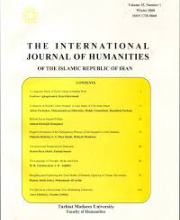۱.
Although the Zarzian was first identified in the 1920s, it has not been until recently that detailed investigations of it have been undertaken. In contrast to the intensive research on the Epipaleolithic period in the Levant, the Zarzian in the Zagros area is less well known, although it shares some similarities (as well as differences) with the Levantine Epipaleolithic including trajectories of hunter-gatherer subsistence and other behavioral strategies that may have played a role in long-term processes ultimately leading in both regions to the advent of food production economies
۲.
An amalgamation of ancient mythological and linguistic features from Ghabrestan Tepe, this article is disposed to introduce some of the oldest findings especially about the then prevailing myths. It can possibly be said that the oldest motifs carved by men, on bones, stones or on cave walls have been the depictions of myths related to Homo sapiens; however, even after the lapse of thousands of years, it is still impossible to find the main tenets they actually tried to narrate through those depictions. Unfortunately, we have to admit that, even the use of modern methods, doesn’t help us to reach to those stories that are much warped and deformed. This article, tries to carry, what has remained from some later version of the myths, backwards in time and, by focusing on a pottery design, uncover what once has been a mythological and significant narrative. Perhaps this had been a well-known mythological story narrated in religious and domestic circles.
۳.
For some 3 million years, the archaeological record is characterized by stone tools undergoing incremental changes. Then around 40,000 years ago, the monotony of lithics is terminated by a profusion of visual representations, generally considered to be the world’s first objets d’art . This collection include a series of portable objects, especially figurines and, later on, the famous cave paintings from western Europe, as well as lesser-known shell-beads in the Levant and painted slabs in Australia. Despite myriad forms and geographic diversity, the figures of this period consistently exhibit a level of sophistication surprising for humanity’s first alleged dabbling in art. Scholars argue over the rate at which art truly emerged. Natural objects engraved with simple geometric designs have been purported to be artistic precursors — the beginning of a gradual trajectory from primitive to developed art. Scientific analysis has confirmed that the appearance of some of these artifacts is consistent with an anthropogenic origin. However, even if they are man-made, the meaning of these objects is unclear. Rather than representing artistic antecedents, they may belong to a separate class of human activity, more akin to modern doodling. This suggestion seems rather plausible due to the fact that the archaeological record has crude geometric etchings and masterful realistic creations, but very little in between. If these categories are part of the same trajectory, where is the middle of the curve?
۴.
Undoubtedly, pottery is among the most important information types that can help understand societies and cultures better. Despite introducing pottery known as Sultān Abād and its classification over the last few decades, very limited information has been published so far on the origin of its type and about archeological sites containing them. The main reason for this seems to be that containers could not be found in archeological excavations, and most of these potteries were obtained through illegal excavations hence; are part of private collections and museums. Consequently, our understanding on their origin, extent and distribution is very limited. In the current study, we attempt to present a brief introduction about the technical and decorative features of this pottery type, its construction origin, historical background and the likely place or places of its production. Then, based on information from recent archaeological excavations and surveys, this pottery type is described and explained.
۵.
Archaeological excavations on the western part of the Central Iranian Plateau, known as the Qazvin Plain provides invaluable information about the sedentary communities from early occupation to the later prehistoric era. Despite the past archeological data, chronological studies mostly rely on the relative use of the Bayesian modeling for stratigraphically-related radiocarbon dates. The current paper provides a new model for excavations and the chronological framework based on new radiocarbon dating of the six key archeological enclosures in the Qazvin plain. A Bayesian analysis of these data is presented on a site-by-site basis to give the best chronologies. Finally, all dates are combined into a single model of the chronology of the Qazvin Plain from the Late Neolithic to the Iron Age. The procedure aims to use the Bayesian model to predict the transition points between the archaeologically-defined periods with the highest possible precision, to redefine the existing chronology for the Qazvin Plain
۶.
The Douzlakh salt mine at Chehr Abad, Zanjan Province, Iran has provided a rare organic preservation of human remains, and associated cloth and clothing. This textile evidence offers a window into a poorly known but pivotal era of textile history. Moreover, the context is of accidental burial of miners at work, rather than deliberate burial of elites. At least six bodies have been recovered, one of which was very well preserved, being fully clothed and carrying items of personal equipment. This paper is a summary of preliminary findings on the textile assemblage.
